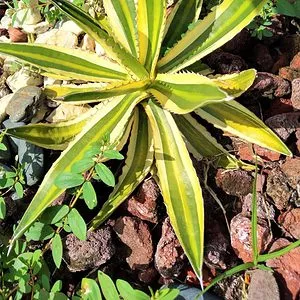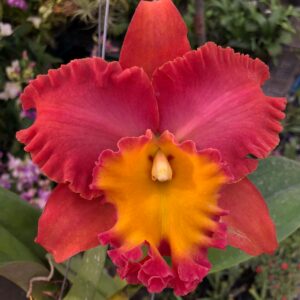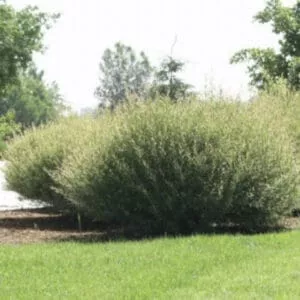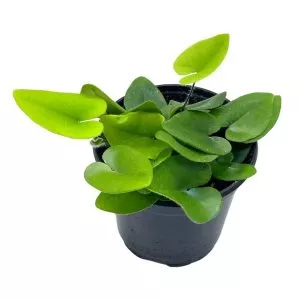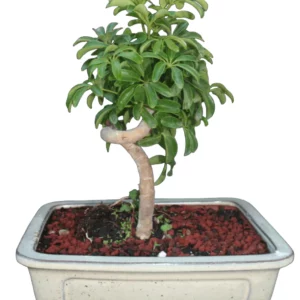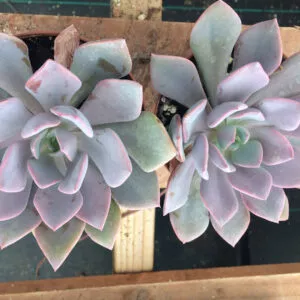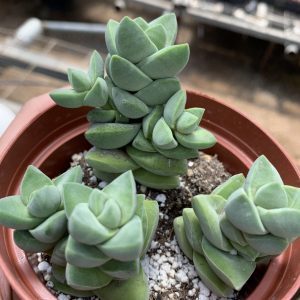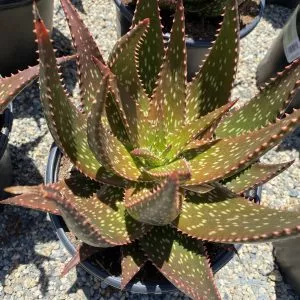No products in the cart.
Table of Contents
Neanthe Bella Palm is considered a functional plant because of its air-purifying capabilities. Not just that, it also has the capacity also to adapt to low light levels! Neanthe Bella is a popular houseplant that is gorgeous, easy to care for, and evergreen.
It is also known as Parlour Palm’s having an attractive, charming, and delicate appearance made up of light green fronds that are about 8 inches (20 cm) long and have a delicacy-like texture that interior designers adore.

Another fun fact for this Parlor palm is that the plant’s genus name is made up of two Greek words: chamai and dorea, which indicates “on the ground” and “gifts,” respectively. This name refers to the plant’s small stature and the ease with which its fruits can be harvested from the ground.
When cultivated outdoors, the Miniature Fishtail Dwarf Palm is a seasonal bloomer that produces tiny yellow flowers.
Want to have another air-purifying houseplant in your home? Well, this beauty is the perfect fit for that! Keep reading for the bigger treat.
Neanthe Bella Palm Plant Care Basics
Take a look first at the plant’s overview. I assure you that it can be a great help in gaining more knowledge about these Neanthe Bella palms.
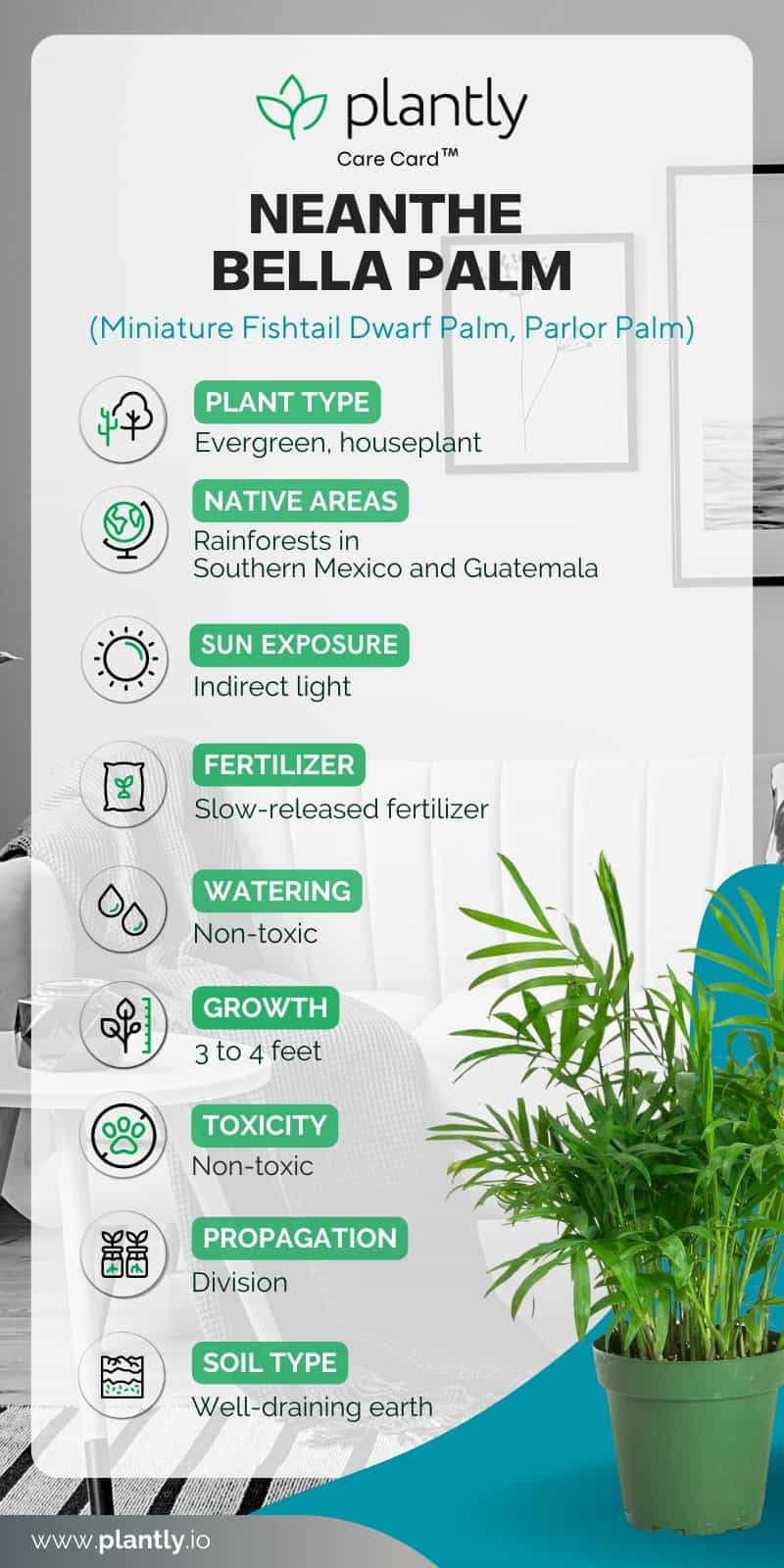
What Type of Soil Is Required?
The Parlor palms thrive in well-draining, nutrient-rich soil. An excellent grade, peat-rich soil-based potting mix is a suitable choice. Although it thrives in consistently moist soil during the Spring and Summer growing seasons, this plant is drought resilient.
Pro tip: The pH of the soil must be between 5.1 and 7.5 for the Neanthe Bella Palm to thrive. The plant may show signs of nutrient deficiency in alkaline soils, such as yellowing of the leaf. The Neanthe Bella Palms may also struggle to use the iron and manganese in the soil if the pH is too high. So check your soil first before planting it.
How Much Water Does It Need?
The soil for the Neanthe Bella palms should never be entirely dry or too damp, as this can cause the plant to wilt. Overwatering might result in a slew of issues. You must thoroughly water it when you water. In fact, you want the water to seep out of the pot’s bottom. This also implies you should check frequently – around twice a week should be enough. Remember that root rot and bugs can occur if the plant is left in standing water for more than 15 minutes.
Pro tip: The amount of water your Parlor palm requires is determined by a variety of elements. This includes the amount of light it receives, the room’s temperature, and humidity conditions.
What’s the Best Light Condition?
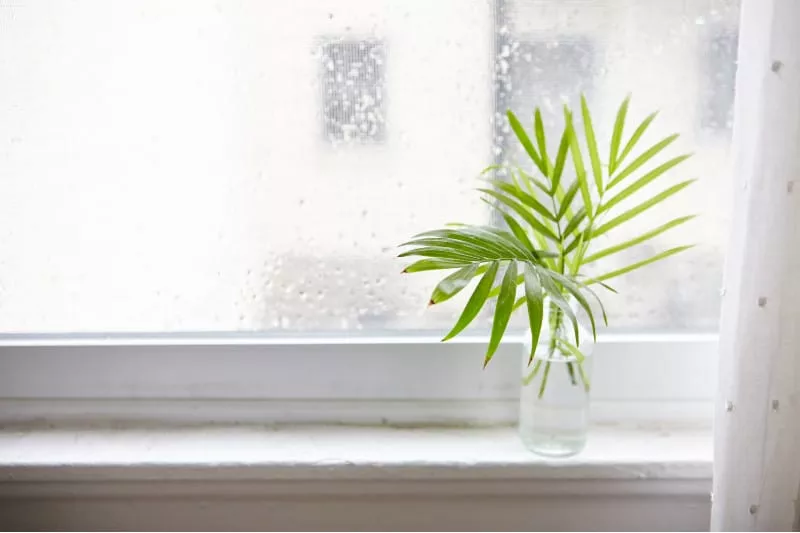
Bright, indirect light is ideal for the Neanthe Bella palms. Although they can tolerate low light conditions, but not too long because they may appear lanky. A room with a north or west-facing window with medium to bright light is also ideal. Remember that they should never be placed in direct sunlight to avoid leaf scorch.
Pro tip: Rotate your Bella palm Chamaedorea elegans regularly to guarantee even development on all sides. You can also dust the leaves frequently to ensure optimal photosynthetic activity.
In stock In stock In stock (can be backordered) In stock
$39.99
Sold By:
Aloha Hawaii Orchids
Miltassia Phoenix Rising ‘White Light’ Comes in 4″ Pot
Rated 4.65 out of 5 based on 268 customer ratings00
Sold By:
Aloha Hawaii Orchids
$12.00
Sold By:
Cacti and Exotica
Euphorbia anoplia
Only 9 available and it’s in 1 people’s basket Rated 4.98 out of 5 based on 59 customer ratings00
Sold By:
Cacti and Exotica
Free Shipping
$27.00
Sold By:
Gar-Zen Botanical Design
Organic Lophanth Quadricolor Agave Ships Free.
Rated 4.86 out of 5 based on 49 customer ratings00
Sold By:
Gar-Zen Botanical Design
$4.95
Sold By:
CTS Air Plants
Hypoestes Pink Splash Live Potted House Plants in 2″ Pot
Only 296 available and it’s in 2 people’s basket
Sold By:
CTS Air Plants
What Temperature Range Is Best?
Temperatures as low as 50 degrees Fahrenheit (10 degrees Celsius) are not a problem for these plants. Just keep in mind that slow or no growth could indicate that the temperature is too low. Talking about the right conditions, the optimal temperature range is between 70 and 80 degrees Fahrenheit (21 and 26.6 degrees Celsius). Warmer temperatures are required for them to reach their full growth potential.
Pro tip: You should keep them away from chilly drafts, such as those found near windows, vents, and exterior doors.
How Much Humidity Is Preferred?
The Neanthe Bella Palm thrives and looks at its finest in high humidity. If the humidity level is too low, the Palm’s fronds may have brown tips. Using various strategies, you may simply mimic its natural climate.
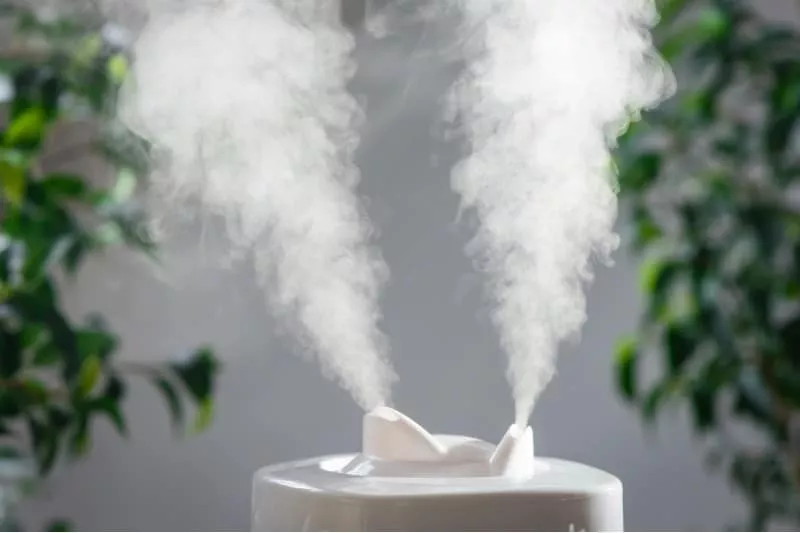
To increase the humidity levels in your Neanthe Bella Palm, you may use a humidifier. Alternatively, you can also place the container on a pebble tray. And last but not least, you can group your plants together to create the proper humidity for all.
How Often Should I Fertilize?
One of the Neanthe bella palm care also includes their feeding. On that note, they can thrive on a slow-release fertilizer starting in the second growing season. Use a couple of teaspoons of a slow-release 8-2-12 palm fertilizer in early spring. Do not allow the fertilizer to come into touch with the leaves when mixing it into the soil.
Remember to not fertilize during the winter! One of the things to note also if you’re overfertilizing this beauty is that the tips of their leaf are brown. So you know what to do: stop fertilizing it.
Pro tip: Prior to planting, you can mix 2 to 3 inches of organic compost or well-composted fertilizer to provide nutrients to the Parlor palm over the first few months.
What Are the Propagation Methods?
Ready to propagate your Neanthe Bella palms? Well, this can be easy-peasy if you’ll just gonna do it right, so don’t worry too much. Plus, we will also guide you all throughout the process. Going back, the simpler option to propagate it is through division. This is also best done in their growing season for higher possibility growth. Here’s how you will propagate your Chamaedorea elegant:
- First, choose a container large enough to hold a single stem from the mother plant. Then, fill it with a soilless mix of peat moss and either vermiculite or perlite in equal proportions.
- Remove the mother plant from its container with care.
- To show the root ball’s bare roots, gently loosen the potting soil surrounding it.
- Next, look for a stem that appears to be healthy and has its own root structure. With a clean, sharp blade, gently cut away any roots that connect it to the main plant.
- Plant your fresh stem in the soilless mix in the container, ensuring the roots and stems are protected by the soil.
- Water the potting soil until it is moist and humid. Allow the baby plant to recover in a warm, shady location and care for them as usual. After a couple of weeks, you may see your Parlor palm healthy and thriving.
Growth Zone
The Neanthe bella palm is hardy in USDA zones 10-12.
What’s the Right Way to Repot?
Bella Neanthe Palms dislike frequent root disturbance. It’s because they have weak root structures, so repotting regularly might be detrimental in the long run. However, if it’s time to repot the plant, it should be re-potted in a six-inch container with sufficient drainage to get it started on the path to reaching its full potential.
Pro tip: When placing the Neanthe Bella Palm in the new container, make sure to compress it tightly around the root ball to hold it in place.
In stock In stock In stock Only 1 left in stock
$34.99
Sold By:
Aloha Hawaii Orchids
$39.99Rlc. Orange Diamond ‘Throat of Gold’ Comes in 2″ Pot
Rated 4.65 out of 5 based on 268 customer ratings00
Sold By:
Aloha Hawaii Orchids
Free Shipping
$16.99 – $39.99
Sold By:
Twigz Nursery
Salix Hybrid Willow Bush Cuttings – Fast Growing Privacy Shade Trees – Easy starts 8-12″
Only 999 available and it’s in 1 people’s basket Rated 4.93 out of 5 based on 90 customer ratings07
Sold By:
Twigz Nursery
$15.99
Sold By:
BubbleBlooms
Heart Fern, Hemionitis Arifolia, 4 inch pot, Heart Leaf, Tongue Fern
Rated 4.81 out of 5 based on 279 customer ratings04
Sold By:
BubbleBlooms
Free Shipping
$87.14
Sold By:
BONSAI WORLD LLC
Large Coiled Umbrella Bonsai Tree
Sold By:
BONSAI WORLD LLC
Is Pruning Required?
Pruning is usually not recommended because these plants do not grow very tall. However, if there are any yellow or brown fronds, you may cut them. Pruning the naturally dead leaves is also recommended.
To avoid plant-related allergies, wear gloves and protective goggles during trimming. Pruning shears or blades also should be sharp and disinfected.
Pro tip: If over pruned, these slow-growing plants will stop growing totally.
In stock In stock In stock (can be backordered) In stock
$39.99
Sold By:
Aloha Hawaii Orchids
Miltassia Phoenix Rising ‘White Light’ Comes in 4″ Pot
Rated 4.65 out of 5 based on 268 customer ratings00
Sold By:
Aloha Hawaii Orchids
$12.00
Sold By:
Cacti and Exotica
Euphorbia anoplia
Only 9 available and it’s in 1 people’s basket Rated 4.98 out of 5 based on 59 customer ratings00
Sold By:
Cacti and Exotica
Free Shipping
$27.00
Sold By:
Gar-Zen Botanical Design
Organic Lophanth Quadricolor Agave Ships Free.
Rated 4.86 out of 5 based on 49 customer ratings00
Sold By:
Gar-Zen Botanical Design
$4.95
Sold By:
CTS Air Plants
Hypoestes Pink Splash Live Potted House Plants in 2″ Pot
Only 296 available and it’s in 2 people’s basket
Sold By:
CTS Air Plants
Neanthe Bella Palm Varieties and Similar Plants
Palm plants add a touch of tropics to every room, as well as a sense of serenity and tranquility. Aside from that, they are loved by most plant people because they are typically low-maintenance. If you’re looking for more Palm plants, we will also provide some of them here! They are:
Areca Palm (Dypsis lutescens)
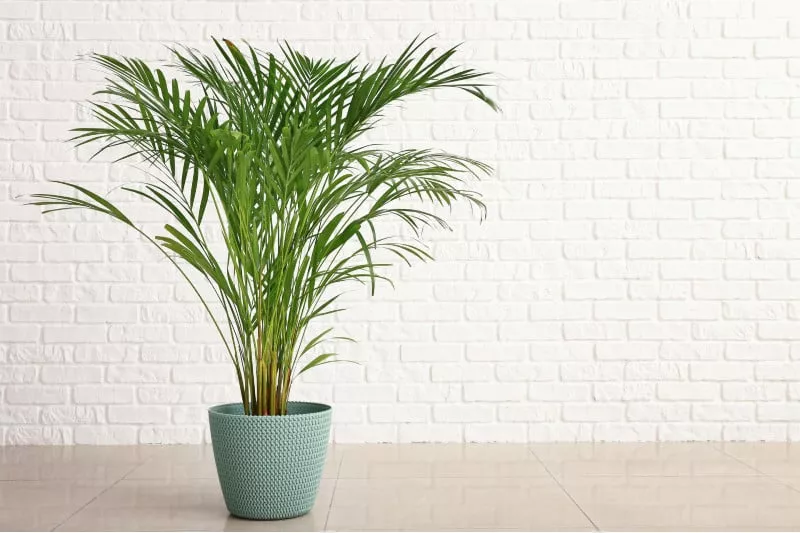
The Areca palm has a common name of the Butterfly palm because of its fluffy, arching fronds that resemble those of a butterfly. The tall, slender stems and green foliage give this Palm a bamboo-like appearance. The Palm grows in clusters as an indoor potted plant, and the thin arching leaves resemble palm grass.
Majestic Palm (Ravenea rivularis)
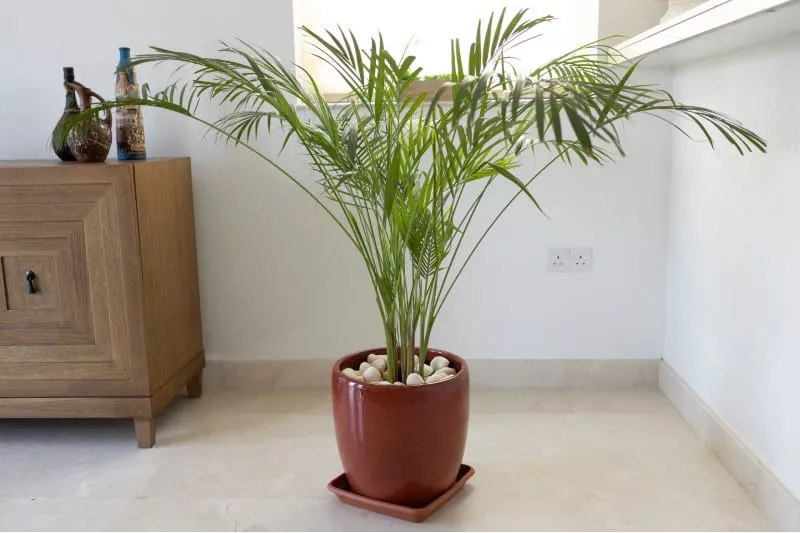
This indoor palm tree is an excellent plant for brightening up a dark corner of the space. One of the reasons this Palm is on the list of most popular houseplant palms is because of its long arching fronds. Because the palm tree may grow up to 98 feet (30 meters) tall, it will eventually overwhelm your space. However, it is a slow-growing palm, so that will take several years to reach that height.
Ponytail Palm (Beaucarnea recurvata)
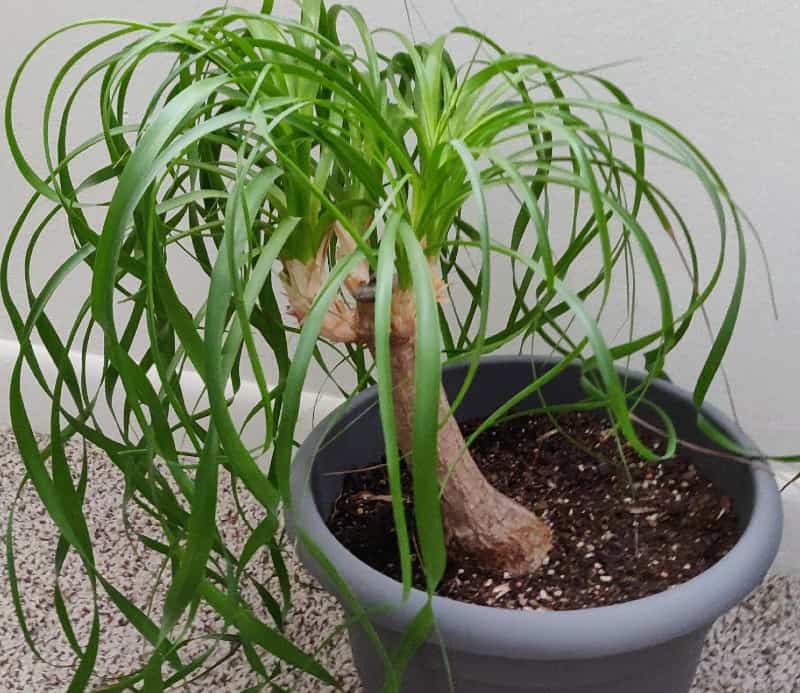
Elephant’s foot palm is another name for this beauty. Crowning leaves are located at the summit of a thick trunk or stem. Even in small pots, the base of the stem is somewhat more significant than the stem, giving this Palm the appearance of an elephant’s foot.
Neanthe Bella Palm Diseases & Pests
Pests
If your home is very warm and dry, spider mites may attack around the plant. You may find small webs on the bottoms of your leaves, and that’s the sign that you’ve got an infestation. But don’t worry! They can be killed with neem oil and insecticidal soap. You may also change your house’s indoor environment to make it more friendly to the Palm and less friendly to the bugs.
Diseases
Fusarium Wilt and Pythidiea Wilt are the most common diseases that affect Parlor Palm. They thrive in hot, humid environments, especially when humidity is high. To treat the ailment, lower the moisture and give your plant less water. This can be accomplished by boosting air circulation in the room and relocating the plant to a dryer part of the house.
Frequently Asked Questions
Cats, dogs, and people are not poisoned by Neanthe Bella Palms. So, you don’t have to be concerned about your pet being near it.
The famous benefit of having these indoor Palms is that they reduce hazardous VOCs (such as ammonia) produced by harsh cleaning. It also has a high transpiration rate, which will help to humidify the air in your home.
This is usually a symptom of arid air. If your plant is developing brown tips, you may be growing it in an area with overly dry air, such as near a radiator or high on a shelf. The best treatment is to consider transferring it to a different location.
You can now have your indoor Palm houseplants here at Plantly! You can also avail of it through our fast transaction online. And will surely deliver your plant without any blemish! Message us now!
Whether you want to buy, sell or simply reach out to other plant enthusiasts, Plantly is the right place to be!
In stock In stock In stock In stock
$9.99
Sold By:
Succulent Oasis
Medium Succulent Plant – Graptoveria Debbie
Rated 4.84 out of 5 based on 352 customer ratings09
Sold By:
Succulent Oasis
Free Shipping
$32.96 – $54.96
Sold By:
CZ Grain
Bur Oak Tree Seedlings to Plant
Rated 4.60 out of 5 based on 156 customer ratings00
Sold By:
CZ Grain
$10.00
Sold By:
Cacti and Exotica
Crassula Moonglow
Only 6 available and it’s in 3 people’s basket Rated 4.98 out of 5 based on 59 customer ratings00
Sold By:
Cacti and Exotica
$59.99
Sold By:
Succulent Oasis
$63.00Succulent Plant Mature Aloe ‘Apache’ Hybrid
Rated 4.84 out of 5 based on 352 customer ratings00
Sold By:
Succulent Oasis


